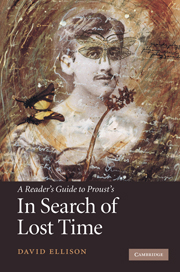Book contents
- Frontmatter
- Contents
- List of illustrations
- Preface
- Acknowledgements
- Chronology
- Introduction: At the threshold of Proust's novel
- 1 Du Côté de chez Swann [The Way by Swann's]
- 2 A l'Ombre des jeunes filles en fleurs [In the Shadow of Young Girls in Flower]
- 3 Le Côté de Guermantes [The Guermantes Way]
- 4 Sodome et Gomorrhe [Sodom and Gomorrah]
- 5 La Prisonnière [The Prisoner] and Albertine disparue [The Fugitive]
- 6 Le Temps retrouvé [Finding Time Again]
- Notes
- Select bibliography
- Index
1 - Du Côté de chez Swann [The Way by Swann's]
Published online by Cambridge University Press: 05 August 2012
- Frontmatter
- Contents
- List of illustrations
- Preface
- Acknowledgements
- Chronology
- Introduction: At the threshold of Proust's novel
- 1 Du Côté de chez Swann [The Way by Swann's]
- 2 A l'Ombre des jeunes filles en fleurs [In the Shadow of Young Girls in Flower]
- 3 Le Côté de Guermantes [The Guermantes Way]
- 4 Sodome et Gomorrhe [Sodom and Gomorrah]
- 5 La Prisonnière [The Prisoner] and Albertine disparue [The Fugitive]
- 6 Le Temps retrouvé [Finding Time Again]
- Notes
- Select bibliography
- Index
Summary
A CURIOUS THREE-PART VOLUME
Shortly after the appearance of Du Côté de chez Swann in 1913, Paul Souday, literary critic for Le Temps, expressed what must have been a widely shared opinion among Proust's first readers:
It seems to me that the large volume by Marcel Proust is lacking in compositional unity, that it is as hyper-extended as it is chaotic, but that it contains precious elements from which the author could have formed an exquisite small book.
Although in retrospect Souday's judgment may appear excessively harsh and off the mark, it must be conceded that the perplexed reviewer had a point. How can any reader, however perceptive, when confronted for the first time by this beautiful yet strange new fictional universe, locate a thread capable of unifying the volume's three quite distinct parts, which bear the titles: Combray, Un Amour de Swann, and Noms de pays: le nom? In Combray, after three introductory sections which function like three narrative false starts, we have an evocation of the small town in which the narrator spent his holidays as a child and the introduction of major characters and fundamental themes that will be developed as the novel evolves. In Un Amour de Swann we find the only sustained section of third-person narrative in the Recherche (the rest of the novel being organized around the reflective consciousness of an “I” or je who is both narrator and protagonist of his own story).
- Type
- Chapter
- Information
- A Reader's Guide to Proust's 'In Search of Lost Time' , pp. 28 - 56Publisher: Cambridge University PressPrint publication year: 2010



